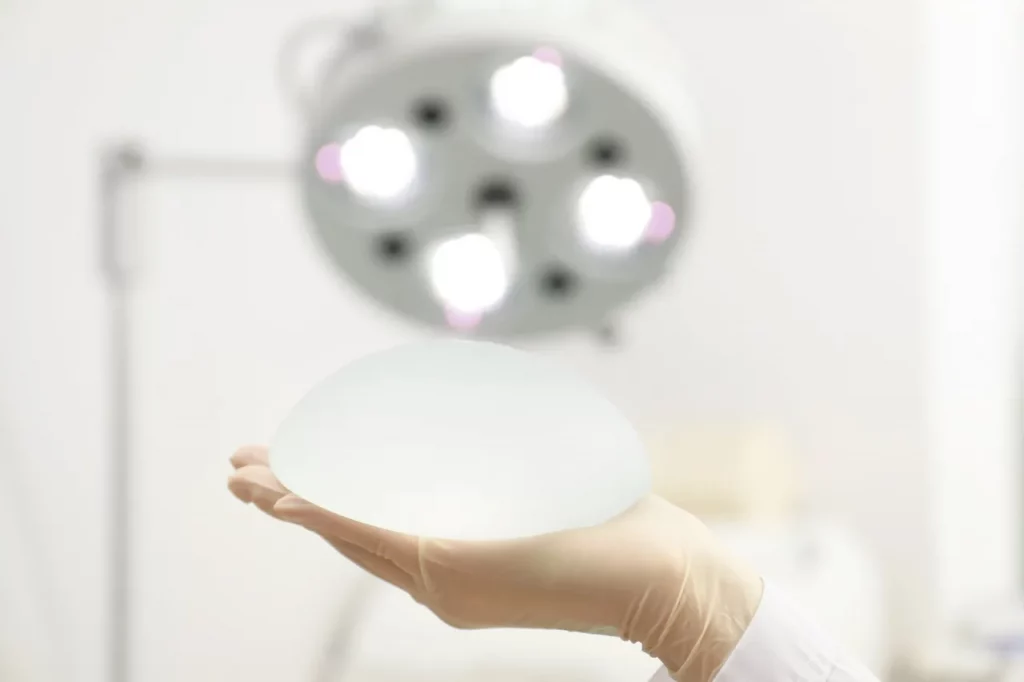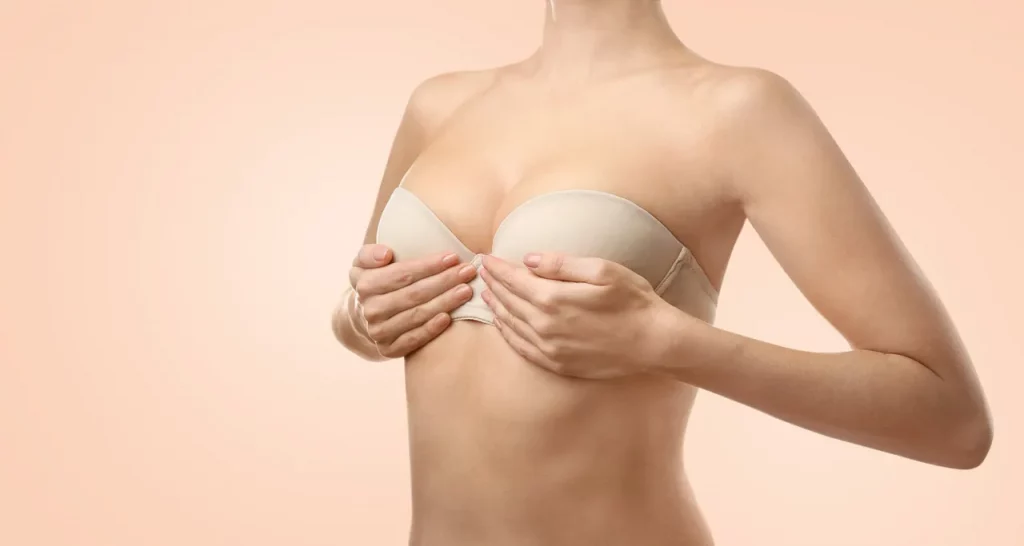Breast augmentation with prostheses in Paris 16 & Paris 7
Breast augmentation surgeon in Paris
Underdeveloped, sagging breasts or breasts that have atrophied as a result of pregnancy or significant weight loss can sometimes be a source of physical and psychological discomfort and a complex. Everyday life is affected, and getting dressed, putting on a swimming costume, assuming one’s nudity and femininity become increasingly difficult.
Depending on the case and the patient’s expectations, breast augmentation using implants may be an appropriate response. This operation is one of the most frequently performed in plastic and aesthetic surgery.
The operation is quick and painless, and the effect is immediate and stable over time. This operation consists of increasing the volume of the breasts by inserting a breast prosthesis, the shape and volume of which vary according to the desired result.
Breast augmentation by prosthesis in Paris 16 & Paris 7
Breast augmentation surgery in Paris 7
Any woman wishing to increase the volume of one or both breasts may be a candidate.
Breast augmentation by implant corrects breasts that are :
Too small: hypotrophy
Non-existent: agenesis
Malformed: asymmetry, tuberous breast syndrome, Poland syndrome, etc.
Sagging or empty: due to ageing, after pregnancy or significant weight loss.
This operation can be carried out alone or in combination with other procedures such as breast lipofilling and/or mastopexy, i.e. breast lifting. At present, the lifespan of a breast prosthesis is around ten years.
It is therefore important to understand that the fitting of breast implants will inevitably require a second operation some ten years later, either to change the implants or to remove them.
All the implants used by Dr Azuelos are CE marked and authorised by the ANSM.


What does breast augmentation involve?
The size, shape and firmness of the prosthesis(s) are decided and validated in advance by the patient and Dr Azuelos before the operation, depending on her morphology, the nature of her skin and the surgical plan defined beforehand during the consultation.
In fact, before the operation, two or three consultations are necessary to define the surgical plan and decide :
The type of implants
Round
The round shape flatters the décolleté by creating volume.
Anatomical
The anatomical shape is closer to the natural shape of the breast.
Volume
Depending on the patient’s morphology, the quality of the skin, the width of the breast and the desired result, a prosthesis volume is chosen to obtain a perfect result by adjusting the base and projection of the implant.
Their position
In front of the muscle (retroglandular), behind the muscle (retromuscular), mixed (dual plane).
Content and firmness
Silicone, whether cohesive or not, remains the most natural choice to the touch, as it feels most like a natural breast when palpated. The more cohesive a silicone gel is, the firmer it is; the less cohesive it is, the more supple it is. Saline has the advantage of being completely resorbed in the event of implant rupture.
The position of the scars
Sub mammary fold, areolar fold, axillary fold
The position of the scar depends on the size of the implant and the patient’s wishes.
In the fold under the breast:
This approach limits the impact of scarring on the breast. As far as the skin is concerned, the scar is hidden in the sub-breast sulcus and remains invisible when wearing a bra or a traditional swimming costume or bikini. This approach also avoids damaging the mammary gland; unlike the areolar approach, it allows the implant to be positioned without passing through the gland.
Areolar :
The areolar approach makes it possible to position a small or moderate-sized implant through an incision located at the lower edge of the mammary areola. Apart from bare breasts, the scar is almost imperceptible. The disadvantage, however, is that a passageway must be created through the mammary gland to insert the prosthesis. This route is therefore less recommended for women who wish to breast-feed or who prefer to preserve the sensitivity of the areola and nipple as much as possible.
Axillary :
The axillary approach, i.e. with a scar in the armpit, is an alternative to the two previous approaches. Once fashionable, it has several disadvantages.
First of all, the armpit area heals less well than the breast area due to friction and its high mobility. Also, the scar is quickly visible if the clothes worn do not have sleeves. Finally, the tunnel created to insert the prosthesis may reopen, with the implant rising up and then moving off-centre above the breast area.
Associated surgery
Lipofilling and breast lift
Breast lipofilling is a procedure for breast augmentation using fat tissue autografting. The fat is taken from another area of the body (stomach, hips, thighs), processed, purified and reinjected into the breasts during the same operation.
A breast lift is used to lift the breasts after a drop in size (ptosis) secondary to weight loss, one or more pregnancies or simply due to age.
In order to prepare for the operation and optimise the results, you should stop smoking at least one month before and after the operation, to limit the risk of complications and, above all, to optimise the healing process.
It is also advisable to stop taking certain medications, such as anticoagulants and aspirin in particular. Certain sporting activities should be temporarily suspended until the healing process is complete.
A mammogram is systematically prescribed before the operation.
Breast augmentation by prosthesis
How is breast augmentation surgery carried out in Paris 7?
Depending on the surgical plan, breast implants are inserted under general anaesthetic during outpatient hospitalisation (discharge the same evening) or a short stay in hospital (one night).
The length of the operation depends on the type of procedure: isolated or combined with lipofilling or mastopexy. Isolated breast augmentation with a prosthesis takes 1 hour. An injection of a long-acting local anaesthetic relieves post-operative pain very well.
The sutures used are generally absorbable.
The first dressing is made by Dr. Azuelos himself in the operating theatre and will also be removed by Dr. Azuelos the day after the operation, in consultation in the case of outpatient hospitalisation (discharge the evening before) or before your discharge if you have slept overnight at the clinic.
Your surgeon will validate your discharge after the first postoperative visit.
How is breast augmentation surgery covered?
In some cases, breast augmentation surgery in Paris may be fully or partially covered by social security in cases of total breast agenesis or breast malformation.
Breast augmentation surgery in Paris 16 & Paris 7
Frequently asked questions
Is it possible to breast-feed after breast augmentation surgery in Paris?
Yes, there are no contraindications to breast-feeding after breast implant surgery, provided, of course, that the implant is healthy. If a patient plans to breast-feed, it is advisable to avoid the areolar route.
What monitoring is required after breast augmentation surgery in Paris?
After the operation and the early post-op period, the clinical examination is used to monitor the progress of the prosthesis. If there is any doubt, an imaging scan (ultrasound, mammography or MRI) should be carried out, especially as the ten-year postoperative period is approaching.
I don't want a prosthesis; what alternatives are there for breast augmentation surgery in Paris?
Apart from breast implants, only lipofilling can be used to increase breast volume for aesthetic purposes.
Can this operation be carried out on an outpatient basis?
Yes, breast augmentation surgery in Paris can be performed on an outpatient basis.
Aesthetic Surgery Paris 7 and Massy
Dr Azuelos on the networks
Here are a few photos of the results obtained thanks to the various surgical procedures or acts of aesthetic and regenerative medicine. As each patient is unique, the final result differs from one patient to the next. These photos are purely for information purposes and illustrate the possible results.
